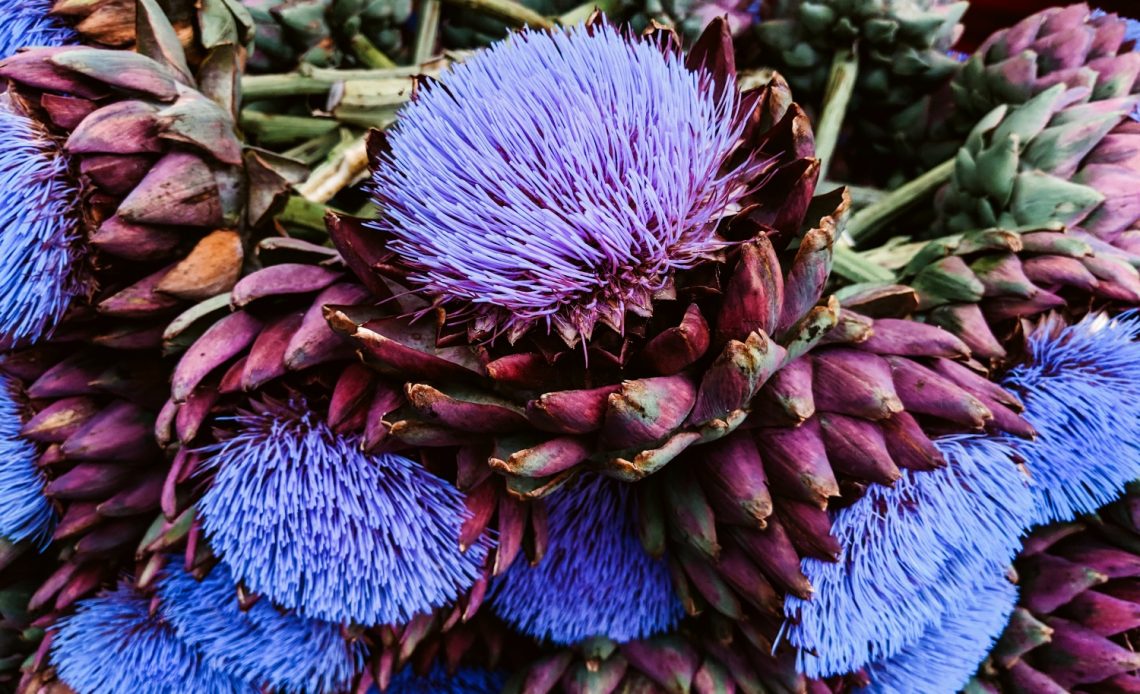

We’re here to help! Wild Yards is a completely free website that is 100% dedicated to helping you create a wildlife-friendly, sustainable yard. Read more
WildYards is reader-supported. When you buy a product through a link on our site, we may earn a comission. Every product is independently selected by our (obsessive) editors and our reviews are unbiased and objective. Read more about our mission or our privacy policy.
Once you’ve tasted artichoke dip, your entire life changes — for the better.
If you’re a gardener, then one bite of artichoke dip is enough to convince you that this is a veggie worth planting!
Artichokes are fairly easy to grow, and they’re loaded with health benefits. Making artichokes a part of your weekly meal plan supports digestive, liver, and cardiac health.
Watching an artichoke grow is a fascinating process, too, and one that becomes all the more rewarding when the artichoke begins to bloom.
That’s right, artichokes can flower!
As is the case with cauliflower, the artichoke heads we harvest are actually flower buds. And, if left on the plant long enough, these flower buds will bloom.
But what are the benefits of allowing artichoke flowers to blossom, and should you let your artichoke plants bloom?
Artichokes flower to reproduce and make seeds. If you want to harvest the artichoke seeds to start new plants, you’ll need to let your artichokes bloom. The flowers are also incredibly popular with pollinators and can help support local bee and butterfly populations.
What are artichoke flowers?
The part of the artichoke that we eat is the flower bud.
Since we harvest the flower bud to bring to the table, we rarely get to see an artichoke in full bloom. And that’s a shame because artichoke flowers are beautiful.
Interestingly, the flower of the artichoke plant has been used as a symbol of hope, prosperity, peace, and resiliency in many cultures.
Artichoke blossoms are lavender-purple and globe-shaped with spiky, needle-like bracts emerging from the center of the bud between the lobed, silvery-green outer petals.
At first glance, you might think a flowering artichoke was a thistle. But even though these two plants are related (they both belong to the family Asteraceae), they are not one and the same.
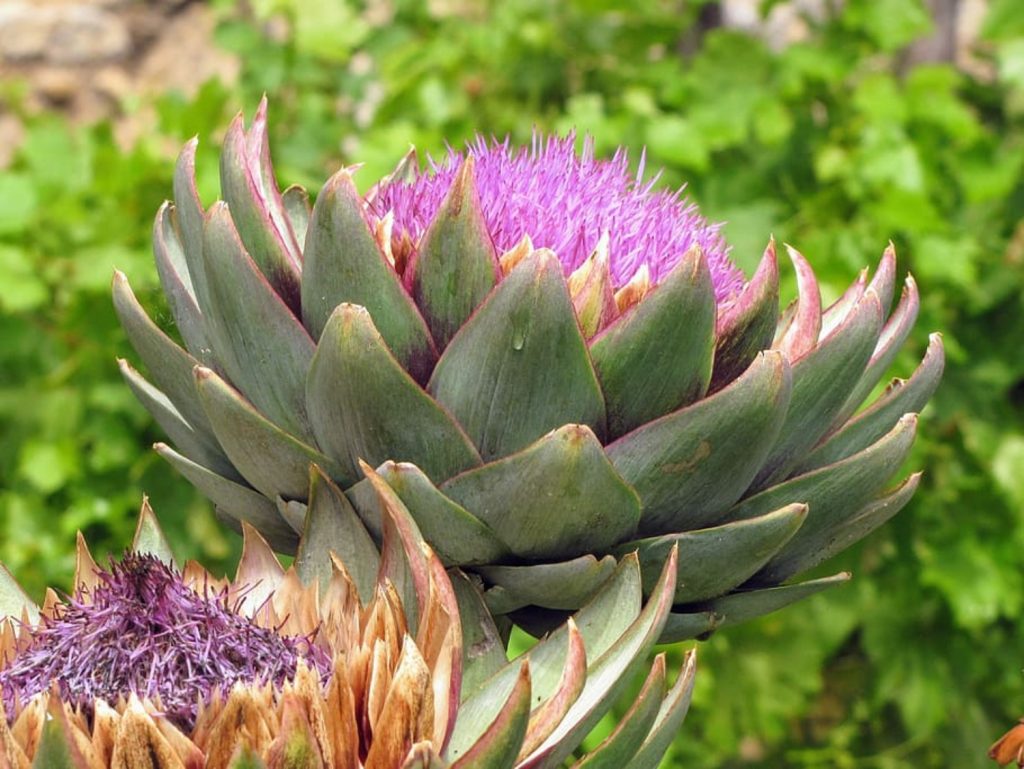
When do artichokes produce flowers?
Artichoke plants typically begin producing flowers in late spring to early summer.
It can take these buds 2 to 4 weeks to bloom, depending on the variety of the artichoke itself and how well its growing requirements are being met.
An artichoke plant can produce anywhere from 4 to 6 flower buds during its first season. Once the plant gets more established, it can produce many more.
During its second season, artichokes typically make between 10 and 12 buds.
If you’ve never grown artichokes before, you may think they’re relatively low-growing. But artichokes can grow quite tall, with stalks reaching upwards of 6 feet.
When allowed to remain on the stalks, artichoke flowers create a stunning display, a gorgeous contrast of purple and green that can help you attract beneficial insects to your vegetable garden — and to your flower beds, too!
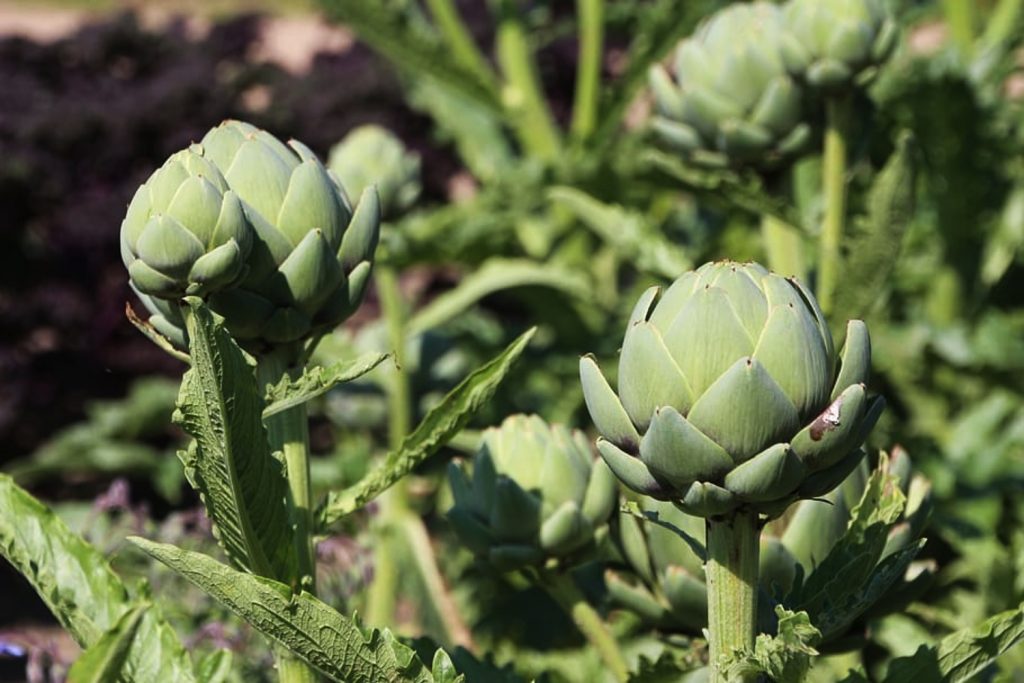
How can you get your artichoke plant to flower?
Artichoke plants flower naturally. It’s all a normal part of their growth cycle, so you don’t have to go to any extraordinary lengths to get them to bloom.
All you really need to do to encourage your artichoke plants to bloom is meet all of the plant’s growing requirements.
| Scientific name | Cynara cardunculus var. scolymus |
| Growing zones | 7 through 11 |
| Light requirements | Full to partial sunlight |
| Soil needs | Fertile, well-draining, sandy to loamy. Prefers high nitrogen fertilizers. |
| Growing season | Spring to autumn |
If you’re a longtime gardener, you know that gardening doesn’t start in the garden. It starts on paper.
Before planting your artichokes, you’ll need to create a garden layout to ensure the plants will be situated in a spot where they receive enough sunlight.
Artichokes perform best when they can receive 4 to 6 hours of sunlight a day. Plants growing in cooler regions will need more sun, and plants growing in warmer areas will need more shade.
Meeting your artichoke crop’s soil requirements is equally important.
If you want your artichokes to bloom, ensure the soil has good drainage.
Artichokes hate sitting in boggy soil. You may need to amend your native soil with horticultural sand if it is too heavy to prevent excess water from pooling around the roots.
Adding a dose of manure and/or blood meal to the mix will help, too. Artichokes love nitrogen-rich organic fertilizers.
Because phosphorus supports healthy reproduction in plants, adding a teaspoon of bone meal to the soil will also encourage the artichokes to make more flowers.
Ensuring all of your artichoke crop’s needs are met is the best way to promote flower production.
While proper fertilization is important to artichokes, adequate irrigation is even more so.
Check the soil regularly. If the soil feels dry an inch below the surface, water the plants deeply. This doesn’t just stimulate flower production, it also encourages the plants to grow strong roots.
Your artichokes need plenty of water to grow well and to produce flowers. But avoid overwatering them, or they may drown.
Ideally, you should keep the soil uniformly moist but never water the plants so much that water is left standing for days.
Should you let your artichoke produce flowers?
The answer to this question depends on why you’re growing artichokes in the first place.
If you’ve planted artichokes to harvest and eat, then there’s no need to let the plants go to flower. In fact, you should avoid allowing them to bloom at all.
Once an artichoke flower bud begins to bloom it is no longer edible. So it’s not like there’s any culinary benefit in allowing artichokes to blossom.
Furthermore, allowing your artichoke plants to begin blooming robs the plant of valuable resources that would otherwise be used to produce more edible buds.
Be sure to harvest your artichokes as soon as they’re ready, and remove damaged, rotting, and deformed buds to prevent the plant from wasting energy on them.
If you’d like to save some artichoke seeds to start new plants next year, or if you’d just like to see the artichoke flowering process in action, then you can leave some or all of the buds on the stalk to bloom.
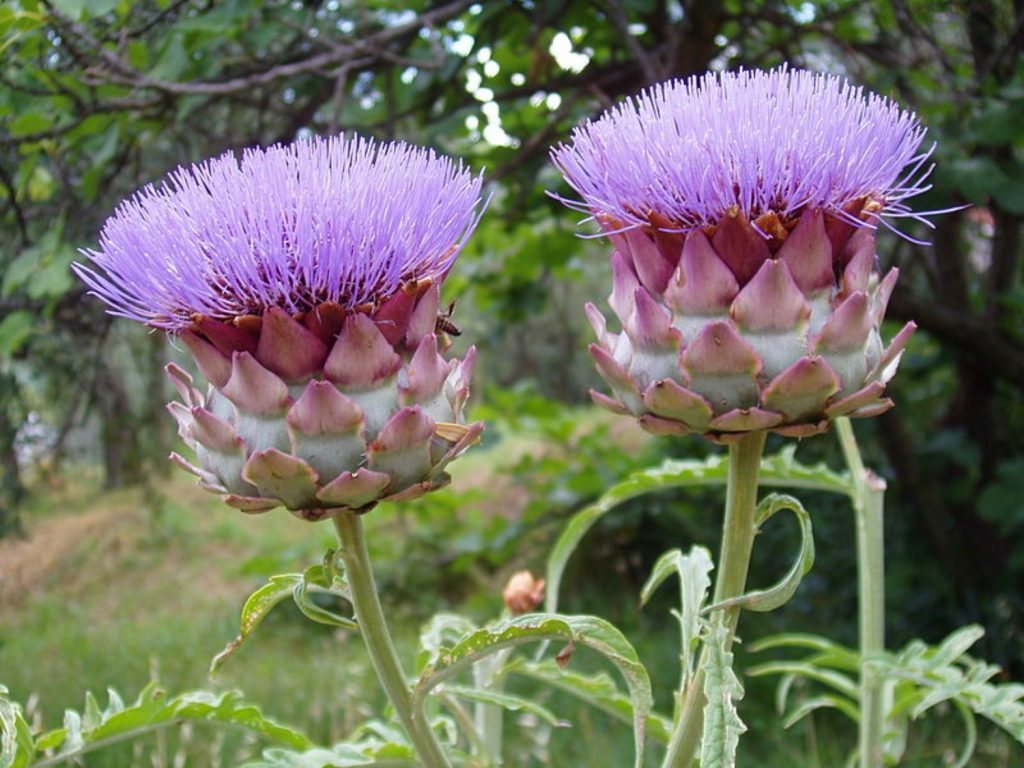
How can you harvest seeds from artichoke blossoms?
Starting artichoke plants from seeds is a bit more challenging than growing tomatoes or peppers, which are generally very easy to sprout.
Of course, that makes the process of growing artichokes from seeds all the more rewarding. Especially if you harvest the seeds yourself!
To gather seeds from your artichoke plants, allow 2 or 3 heads to flower. Eventually, the blossoms will fade from purple to white as the petals age and dry out.
At this point, the flower heads will begin to resemble wish flowers. That’s when you know they’re ready to be trimmed from the plant.
Clip the flower head just below the bud, where the base meets the stem. Be careful not to jostle the flower head around too much, so you don’t lose the seeds before you can gather them.
Next, use your fingers to gently pry apart the flower bud. You’ll notice the seeds themselves are attached to hairy carriers that allow them to be blown away by the wind.
Once you’ve collected the carriers, take a look at the bottom. You’ll find a small brown oval-shaped seed, which you can easily remove from the carrier.
Gather the seeds into a bowl to keep track of them as you harvest, then transfer them to a brown paper bag for storage.
You can toss the carriers into your compost bin, or toss them into the wind for fun. The carriers themselves will not produce more artichoke plants, so there’s no need to keep them.
Should you plant artichokes in your flower beds?
Artichokes are a beloved vegetable, but they can be grown as an ornamental as well.
These attractive purple flowers add interest, texture, and variety to any garden. They’re also a hit with pollinators, particularly bees who love to nestle in between the bracts as they collect pollen and nectar.
Butterflies, too, enjoy browsing around gardens where artichoke flowers are blooming. Growing artichokes in your flower beds is a great way to support your local pollinators.
In fact, research shows that pollinators improve seed production in artichokes.
Artichokes can be grown as ornamentals for vegetable gardens, too. And not just to support the pollination of your crops.
Even if you don’t care for the taste of artichokes, growing them in your garden can support healthy fruit development.
The artichoke’s brilliant purple flowers attract all manner of beetles, hoverflies, and wasps — insects that like to prey on pests like aphids, mites, and thrips.
Keeping artichokes in your garden, and allowing them to flower, brings more of the beneficial insects to your garden while simultaneously keeping more of the bad insects out. Talk about a win-win situation!
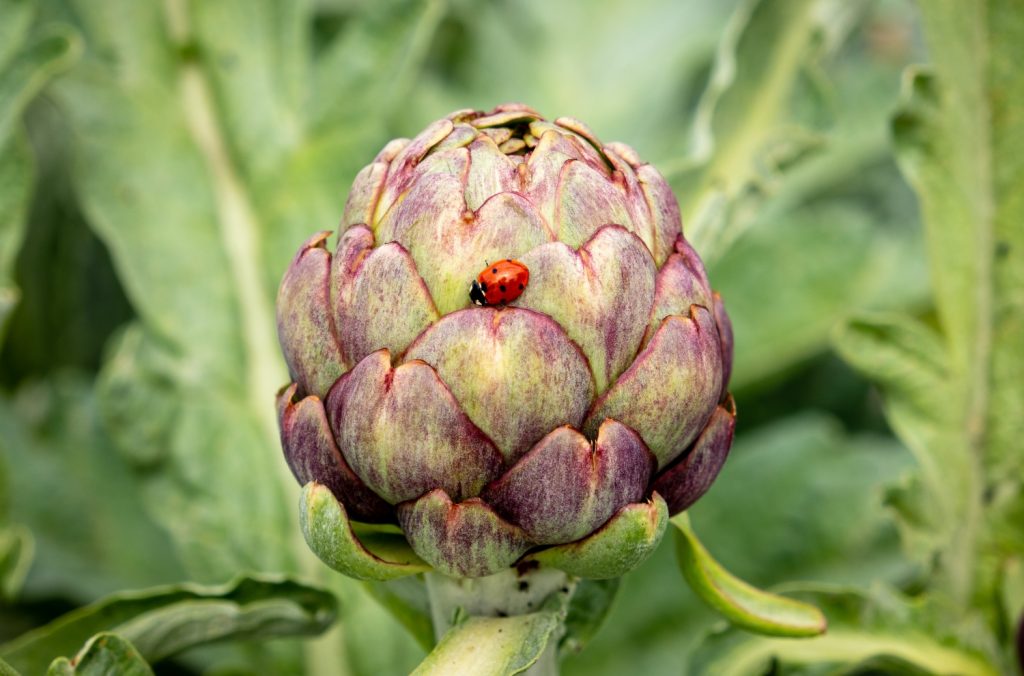
The benefits of growing artichoke flowers
Once an artichoke bud begins to blossom, it may no longer be edible, but it can still be useful!
By providing your local pollinators with a reliable source of food, artichoke flowers support the health of your entire garden.
You can even harvest the flowers to create your own floral arrangements.
Artichoke flowers can last for days in water, and pair extremely well with other members of the Asteraceae family, including sunflowers, daisies, and coneflowers.
So this growing season, why not let a few of those artichoke heads bloom? You might be surprised by how well these beautiful flowers can light up your backyard!
